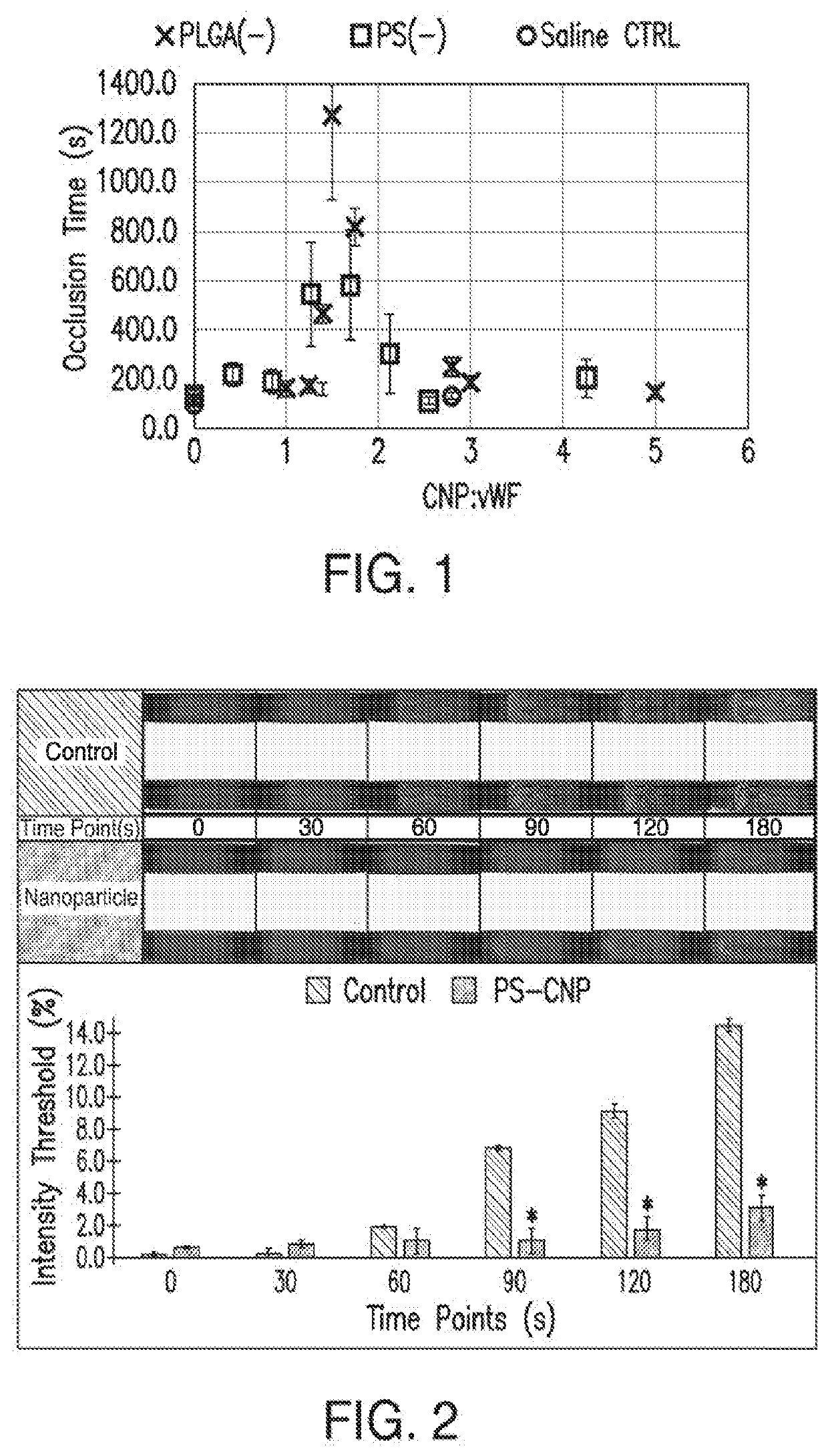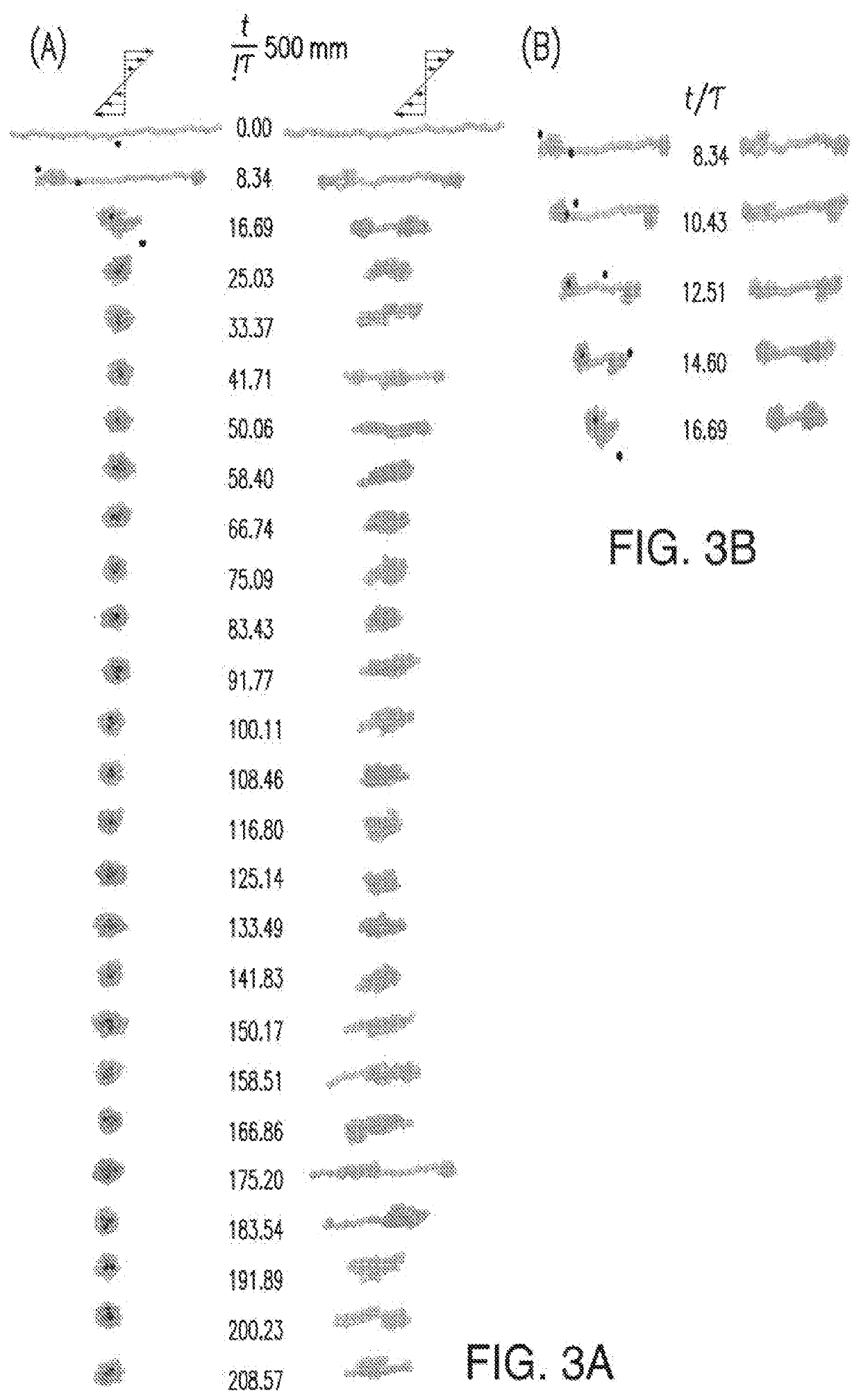Compositions and Methods for Inhibiting Shear Induced Platelet Accumulation
a technology of shear induced platelet accumulation and nanoparticles, which is applied in the direction of drug compositions, peptide/protein ingredients, extracellular fluid disorders, etc., can solve the problems of toxic, no functionalized particle developed to fully alleviate non-responsive therapies, and drugs that do not work as intended for the entire population, so as to reduce the interaction, inhibit or reduce the bioactivity of vwf, and reduce the effect of interaction
- Summary
- Abstract
- Description
- Claims
- Application Information
AI Technical Summary
Benefits of technology
Problems solved by technology
Method used
Image
Examples
example 1
particles Reduce Occlusion Time
Materials and Methods
[0044]Biodegradable PLGA nanoparticles of negative surface charge were fabricated in house by nanoprecipitation methods. 100 mg of RG503H Resomer® (Sigma Aldrich) was dissolved in an 85:15 acetone to ethanol mixture. The dissolution was performed over 5 minutes at 150 g stirring. Ultrapure water was added with continued stirring at 150 g for 3 hours to create a final concentration of 10 mg / mL. Carboxylated polystyrene (PS) nanoparticles of 60 nm size were also purchased at a concentration of 10 mg / mL (Bangs Laboratories).
[0045]Particles were stored at 4° C. until needed for characterization or whole blood treatment. Prior to use, the particles were sonicated for 15 minutes and vortexed for 10 seconds to evenly disperse with minimal agglomeration. Characterization of average diameter and zeta potential was performed by addition of 100 μL of the 10 mg / mL particle mixture to 900 μL of deionized water for a final test concentration of ...
example 2
y Charged Particles Induces a Reduction in the Rate of Shear-Induced Platelet Accumulation
Materials and Methods
[0050]Porcine whole blood was obtained from a local abattoir (Holifield Farms, Covington, Ga.) and lightly heparinized at 3.5 USP units / mL. Blood was stored at room temperature on a rocker prior to testing. All testing was completed within 8 hours after collection.
[0051]Blood samples were treated with a PLGA particle dose of 28 μg / mL blood as the test group, with a non-treated blood group utilized as the control.
[0052]Microfluidic chips were created by casting PDMS (Sylgard 184, Krayden) on a custom-etched silicon 3D stenotic microfluidic mold. After plasma bonding the PDMS to 25×75 mm glass slide, the devices were coated with bovine type I fibrillar collagen (Chronopar, Chronolog, Inc.). The fibrillar coating method was detailed previously by Casa et al, where microfluidic channels were filled with a 100 μ.g / mL collagen type I solution in 0.9% saline and incubated in a hum...
example 3
onal Simulation of Charged Nanoparticle-vWF Interaction
[0054]In this section, we demonstrate the consequence of the interaction of one or more negatively charged particles with the vWF in shear flow. The results here are based on physical and mathematical modeling and analysis. Significant conformational changes occur even when one charged nanoparticle attaches to vWF. With zeta potential and concentration of charged nanoparticle and vWF used in experiments of Examples 1 and 2, we present a summary of the analysis based on physical principles.
[0055]Based on this analysis, the relevant time scale here is the particle (monomer) Brownian diffusion time, τ. Several cases have been simulated where the ratio of the number of charged nanoparticles to the number of vWF is varied, as well as shear rate and the particles charge. Typical results at shear rate 6000 1 / s are shown in FIG. 3. The initial condition is fully elongated vWF release in very dilute suspension of charged nanoparticles, a...
PUM
| Property | Measurement | Unit |
|---|---|---|
| average diameter | aaaaa | aaaaa |
| diameter | aaaaa | aaaaa |
| diameter | aaaaa | aaaaa |
Abstract
Description
Claims
Application Information
 Login to View More
Login to View More - R&D
- Intellectual Property
- Life Sciences
- Materials
- Tech Scout
- Unparalleled Data Quality
- Higher Quality Content
- 60% Fewer Hallucinations
Browse by: Latest US Patents, China's latest patents, Technical Efficacy Thesaurus, Application Domain, Technology Topic, Popular Technical Reports.
© 2025 PatSnap. All rights reserved.Legal|Privacy policy|Modern Slavery Act Transparency Statement|Sitemap|About US| Contact US: help@patsnap.com


